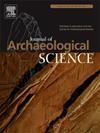Deciphering the origins of Sanxingdui bronzes through petrographic and elemental analysis of casting cores
IF 2.6
1区 地球科学
Q1 ANTHROPOLOGY
引用次数: 0
Abstract
Sanxingdui, one of the most significant Bronze Age sites in China, has yielded unique bronze artifacts with varying styles: some exhibit distinct local characteristics, while others resemble central Shang designs, raising questions about their origins. This study applies semi-quantitative petrographic observations and elemental analysis to 39 casting core samples from Pits 1 and 2 at Sanxingdui. The results reveal distinct differences in production techniques and materials between vessel and non-vessel artifacts. Comparative analysis with local soils, sediment, and casting cores from other Chinese bronze production sites suggests that non-vessel bronzes were likely cast locally near Sanxingdui, while vessel artifacts show connections to the middle and lower Yangtze River region. Our findings indicate that Sanxingdui bronzes were part of a larger, interconnected circulation network for bronze products and ores, reflecting complex cultural, technological, and material exchanges with other regions during the Shang period.
通过岩石学和铸芯元素分析解读三星堆青铜器的起源
三星堆是中国最重要的青铜器时代遗址之一,出土了风格各异的独特青铜器:一些表现出鲜明的地方特色,而另一些则类似于商朝中部的设计,这让人们对它们的起源产生了疑问。本文对三星堆1、2号坑39个铸造岩心样品进行了半定量岩石学观察和元素分析。结果揭示了容器和非容器文物在生产技术和材料上的明显差异。与当地土壤、沉积物和其他中国青铜器生产地点的铸造岩心进行比较分析表明,非器皿青铜器很可能是在三星堆附近铸造的,而器皿器物则显示了与长江中下游地区的联系。我们的发现表明,三星堆青铜器是一个更大的、相互关联的青铜器产品和矿石流通网络的一部分,反映了商代与其他地区复杂的文化、技术和物质交流。
本文章由计算机程序翻译,如有差异,请以英文原文为准。
求助全文
约1分钟内获得全文
求助全文
来源期刊

Journal of Archaeological Science
地学-地球科学综合
CiteScore
6.10
自引率
7.10%
发文量
112
审稿时长
49 days
期刊介绍:
The Journal of Archaeological Science is aimed at archaeologists and scientists with particular interests in advancing the development and application of scientific techniques and methodologies to all areas of archaeology. This established monthly journal publishes focus articles, original research papers and major review articles, of wide archaeological significance. The journal provides an international forum for archaeologists and scientists from widely different scientific backgrounds who share a common interest in developing and applying scientific methods to inform major debates through improving the quality and reliability of scientific information derived from archaeological research.
 求助内容:
求助内容: 应助结果提醒方式:
应助结果提醒方式:


